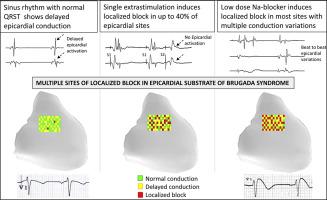Heart Rhythm ( IF 5.6 ) Pub Date : 2021-11-01 , DOI: 10.1016/j.hrthm.2021.10.030 Michel Haïssaguerre 1 , Koonlawee Nademanee 2 , Frédéric Sacher 1 , Ghassen Cheniti 3 , Mélèze Hocini 1 , Elodie Surget 1 , Rémi Dubois 4 , Edward Vigmond 5 , Olivier Bernus 4

|
Background
The Brugada pattern manifests as a spontaneous variability of the electrocardiographic marker, suggesting a variability of the underlying electrical substrate.
Objective
The purpose of this study was to investigate the response of the epicardial substrate of Brugada syndrome (BrS) to programmed ventricular stimulation and to Na blocker infusion.
Methods
We investigated 6 patients (all male; mean age 54 ± 14 years) with BrS and recurrent ventricular fibrillation. Five had no type 1 BrS electrocardiogram pattern at admission. They underwent combined epicardial-endocardial mapping using multielectrode catheters. Changes in epicardial electrograms were evaluated during single endocardial extrastimulation and after low-dose ajmaline infusion (0.5 mg/kg in 5 minutes).
Results
All patients had a region in the anterior epicardial right ventricle with prolonged multicomponent electrograms. Single extrastimulation prolonged late epicardial components by 59 ± 31 ms and in 4 patients abolished epicardial components at some sites, without reactivation by surrounding activated sites. These localized blocks occurred at an initial coupling interval of 335 ± 58 ms and then expanded to other sites, being observed in up to 40% of epicardial sites. Ajmaline infusion prolonged electrogram duration in all and produced localized blocks in 62% of sites in the same patients as during extrastimulation. Epicardial conduction recovery after ajmaline occurred intermittently and at discontinuous sites and produced beat-to-beat changes in local repolarization, resulting in an area of marked electrical disparity. These changes were consistent with models based on microstructural alterations under critical propagation conditions.
Conclusion
In BrS, localized functional conduction blocks occur at multiple epicardial sites and with variable patterns, without being reactivated from the surrounding sites.
中文翻译:

Brugada综合征心外膜基质多部位传导阻滞
背景
Brugada 模式表现为心电图标记的自发变异性,表明潜在的电基板的变异性。
客观的
本研究的目的是研究 Brugada 综合征 (BrS) 心外膜基质对程序性心室刺激和钠阻滞剂输注的反应。
方法
我们调查了 6 名患有 BrS 和复发性心室颤动的患者(均为男性;平均年龄 54 ± 14 岁)。五人入院时没有 1 型 BrS 心电图模式。他们使用多电极导管进行了心外膜-心内膜联合标测。在单次心内膜外刺激期间和低剂量阿马林输注(5 分钟内 0.5 mg/kg)后评估心外膜电图的变化。
结果
所有患者的心外膜右心室前部区域均有延长的多分量电图。单次额外刺激将晚期心外膜成分延长 59 ± 31 毫秒,并且 4 名患者在某些部位取消了心外膜成分,而周围激活部位没有重新激活。这些局部阻滞发生在 335 ± 58 ms 的初始耦合间隔,然后扩展到其他部位,在多达 40% 的心外膜部位观察到。Ajmaline 输注延长了所有患者的电图持续时间,并在与额外刺激期间相同的患者中 62% 的部位产生了局部阻滞。ajmaline 后的心外膜传导恢复间歇性地发生在不连续的部位,并产生局部复极的逐搏变化,从而导致明显的电差异区域。
结论
在 BrS 中,局部功能性传导阻滞发生在多个心外膜部位并具有不同的模式,而不会从周围部位重新激活。









































 京公网安备 11010802027423号
京公网安备 11010802027423号